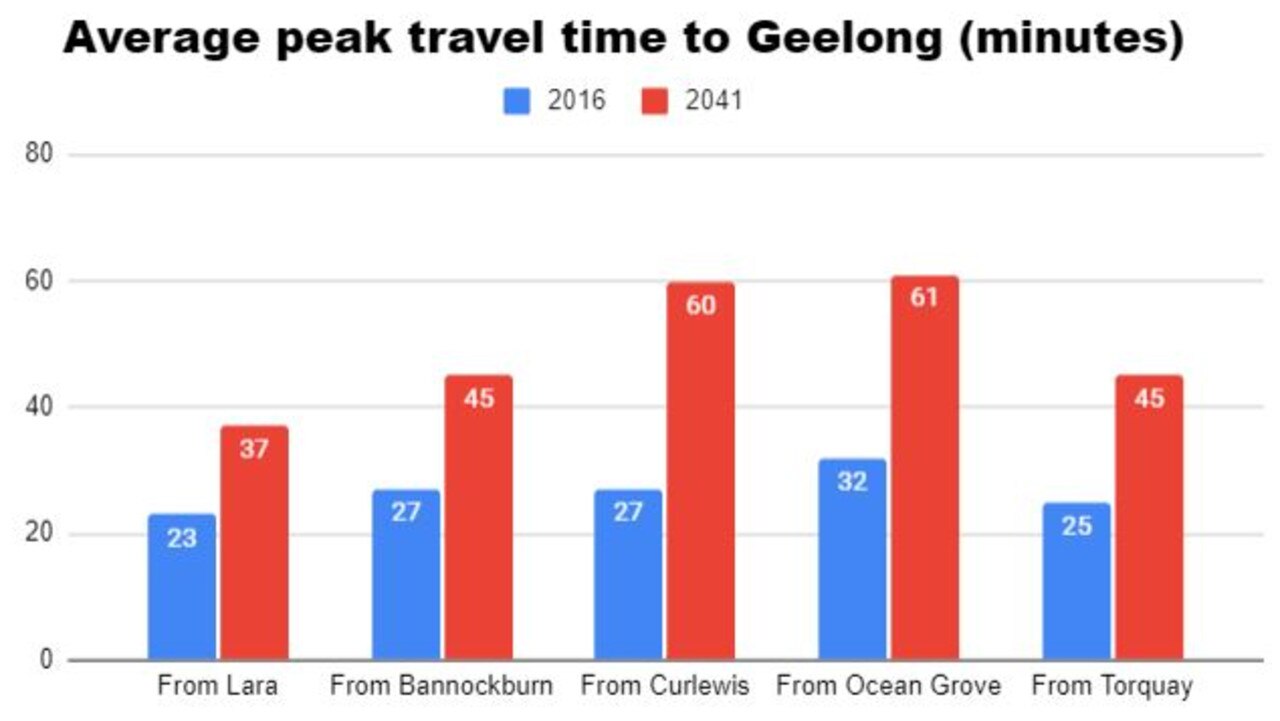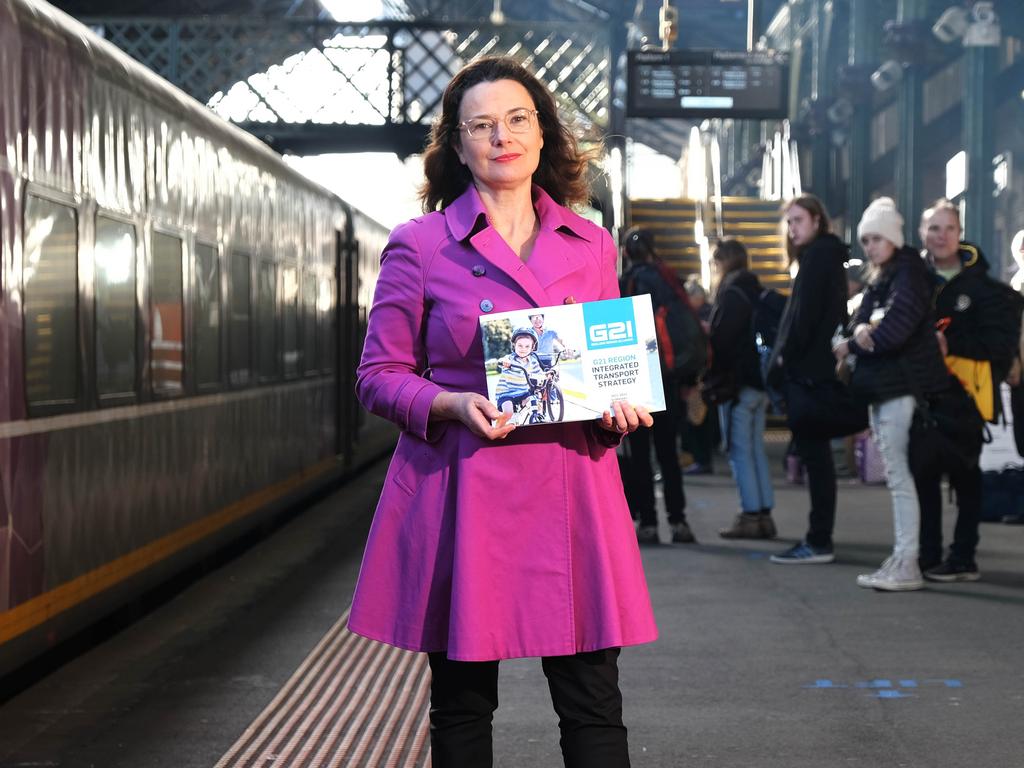Delays for drivers caught in traffic on Greater Geelong roads will be five times worse in 2041 than in 2016, with the potential for “permanent and unmanageable” road chaos destroying the regions’s liveability, new modelling has shown.
The predictions in the G21 – Geelong Region Alliance’s transport strategy reveal drivers on Greater Geelong roads will collectively spend an extra 60,000 hours a year in cars by 2041 if status quo transport planning and delivery continues.
The modelling shows 40 per cent of those delays would happen during the morning peak.
Expert analysis of the current transport planning and patterns, commissioned by G21 for its transport strategy, predicts a future where traffic delays threaten the region’s liveability.

The strategy, developed by town planner Urbis, predicts that by 2041:
THE average speed on urban Geelong roads could drop to 36km/h, from 51km/h in 2016;
A morning commute from Curlewis to Geelong, and from Ocean Grove to Geelong, could blow out to 60 minutes;
THE AM commute from Lara to Geelong could hit 37 minutes, and 45 minutes between Bannockburn and Geelong;
TRAFFIC bedlam could be been seen on Bellarine Highway and Portarlington Rd, where speeds during the peak could be between 9km/h and 20km/h;
The modelling, prepared by Veitch Lister Consulting, relied on hundreds of data sets around movement and government plans for growth.
The modelling was validated using 2016 census data, the latest data available at the time of production, and developed using methodology used for predictions that underpinned planning for the Geelong Ring Rd, the Westgate Tunnel, EastLink and the Melbourne Metro tunnel.

Population growth heaps pressure on transport
Collectively the population in Greater Geelong, Surf Coast, Queenscliffe, Golden Plains and Colac-Otway council areas is due to hit 536,000 by 2041, meaning about 110,000 extra drivers will be on the region’s roads.
G21 chief executive Giulia Baggio said without investment to deliver convenient and reliable public transport in and between major population centres, the region risked “locking in permanent and unmanageable road congestion”.
“We need to start this investment now … otherwise, our cities and towns will be heading to a standstill by 2041 with a car-dependent population of more than half a million people,” Ms Baggio said.
“Heavier traffic volumes are already hampering access to jobs, education, recreation and services across the region.”
Congestion busting solutions
To bust congestion by 2014 G21’s transport strategy recommends:
CREATING a passenger rail network between Bannockburn and Geelong with stops at Moorabool, Bell Post Hill and Gheringhap;
DOUBLING public transport use from 3 per cent to 7 per cent;
DEVELOPING an ‘inward’ Geelong train network by running a minimum of eight-return shuttle services between Lara and Waurn Ponds;
CONNECTING the Surf Coast Highway at Mount Duneed to Barwon Heads Rd at Charlemont to get trucks out of Geelong’s CBD;
INTRODUCING rapid buses between key population centres such as Torquay and Geelong, and Geelong and Armstrong Creek;
CAPPING parking in central Geelong;
INCREASING housing density around public transport corridors; and
duplicating the Midland Highway to Bannockburn via a $265m spend.
Without action car-mageddon future awaits
Veitch Lister Consulting managing director Nick Veitch said the firm’s modelling for Geelong transport patterns in 2041, which underpin G21 strategy, shows major arterials in and out of Geelong would be overcapacity and experience significant congestion.
“The modelling paints a pretty bleak picture. We have an opportunity now to actually make a difference and try and make some changes to transport planning and delivery,” Mr Veitch, whose firm has completed transport planning for the state government for more than 20 years, said.
“Where we are going with growth based on Geelong’s outskirts, it is going to create a car-mageddon possibility in 2041 where there is going to be extreme congestion, people are going to struggle to get to where they conduct daily activities.
“Continual suburban sprawl makes it very challenging to provide adequate public transport networks.
“We need to make sure we are getting more investment in public transport and other sustainable modes of transport such as walking and cycling networks so we can get people out of their cars and onto other suitable transport.
“Using this modelling most of the major arterials heading towards Geelong will be overcapacity and experiencing significant congestion — much lower than the 41km/h average across the region.”
G21 is not talk fest but important community asset, Baggio says
G21’s transport strategy was developed after consultation with about 400 Geelong community and business members during the past 18 months.
G21 chief executive Giulia Baggio said the transport strategy, to be used to lobby state and federal government, showed the danger of adopting a business-as-usual approach to transport planning and delivery.
The organisation’s future beyond April next year is unclear after Geelong council, the organisation’s major funder, voted to end its $500,000 per year contribution due to budget pressure.
Ms Baggio said the organisation wanted to push on.
“There’s no question the regional approach is appreciated at state and federal level – we do the work of consulting the community over large areas, and we join the dots.
“It builds confidence for investment. It helps the councils.
“When we can work together as a region it is a huge strength; it is an enormous asset to have this collaborative approach.

“It bears fruit. Last week the Commonwealth Games fell over, and we were instantly there ready with our full list of projects that we can readily provide to government when funding is available.
“There is a huge pivot here in terms of the regional investments we need to make, and we’re absolutely ready for that because we have done the work for 21 years.
“We keep (our work) constant, we keep it fresh and governments know we are collaborating across communities to bring forward this kind of work.
“That way we prosper as a region because others aren’t organised in the same way.
“It’s hard to put a dollar figure on it, and it’s easy to dismiss it as a talk fest, but you can see that it’s not.
“At these moments when something changes, and you need to be ready, we’re there straight away. Politicians know were to come to get the advice.”
Transport will be a key topic at G21’s annual forum on Friday.



Add your comment to this story
To join the conversation, please log in. Don't have an account? Register
Join the conversation, you are commenting as Logout
Gallery: FUSE Dance 2025 concert
FUSE Dance held its 2025 concert at the Story House Theatre, Geelong Arts Centre on Sunday. SEE THE PICTURES.
Gallery: Geelong Cheer and Elite Dance Studio Showcase
Cheer Geelong and Geelong Elite Dance Studio held their 2025 showcase at the Leisuretime Centre and Sport Precinct. SEE THE PICTURES.